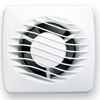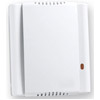Extractor Fans
Introduction
As kitchens, bathrooms and laundries are particularly prone to condensation, its important to provide some means of expelling the moist air along with any potentially unpleasant odours with may form. In this regard, electrical extractor fans are a relatively cheap and easy to fit solution to quickly freshening a room without the potential for draughts.
- Current building regulations require all kitchens and bathrooms to have "adequate air extraction".
Types of fan
At the most basic level, 2 distinct types of extractor fan are available, these are;

Axial fans can either be mounted directly into a window or, using a short length of ducting, into an exterior wall.

Centrifugal extractor fans are often mounted into a ceiling, as these fans are able to overcome the air pressure resistance generated by long lengths of ducting.
Extractor fans also vary by;
- Size the larger the size the greater the volume of air flow per hour.
- Low voltage which are ideal for bathrooms as, with their own transformer, these fans can be mounted directly over a shower.
- Automatic fans which switch on automatically when the humidity in the room reaches a pre determined level.
- Self regulating fans which incorporate a built in controller to regulate the rate of air flow, and a timer to turn the fan off after a set interval.
Choosing the correct size of fan
The size, or capacity, of the fan should be determined by the type of room it is to be installed in, as different rooms require different rates of air flow. Typically one considers the rate of air flow as the number of complete changes of air within the room per hour;
- Kitchen 10-15 times per hour
- Bathroom 6-8 times per hour
- Bathroom with shower 15-20 times per hour
- WC 6-10 times per hour
- Living room 4-6 times per hour. This number is larger if the room is smoky
The capacity of a fan is often defined as volume in cubic metres (cu m), or cubic feet (cu ft), per hour.
To determine the minimum capacity of fan required, calculate the volume of the room (length x width x height) then multiply by the recommended number of air changes required (above).
Positioning the fan
Most obviously, the best place to position an extractor fan is either in a window or an exterior wall. However, esthetical reasoning aside, this rule of thumb is often complicated by the location of the source of fresh air or put simply the door.
A fan works best when sited opposite to the door to allow the air to circulate through the room from the door to the fan. In a kitchen the best site is often adjacent to, or over, the cooker to prevent steam from being drawn across the room.
- Always ensure that you check the chosen site of the fan using a pipe & cable detector to ensure that you do not drill through any water pipes or electrical cables.
- Do not position a fan too close to a door as this will provide air circulation at the door but have little of no effect on the rest of the room.
- If the room contains a fuel burning appliance, such as an aga, with a flue, you must ensure that there is adequate replacement air within the room to prevent fumes being drawn down the flue by the action of the extractor fan when it is switched on. The exception to this is if the appliance has a balanced flue which draws air from the outside, rather than from within the room.
Further information and useful links
- Find a Extractor Fan supplier near you
- Find an Electrician near you
Site Pages
Featured Articles





